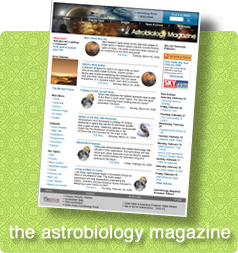
"Where is life concentrated in the ocean? What are its limits? Is life everywhere in the ocean? "
-
NASA's Carl Sagan Fellows to Study Extraterrestrial Worlds

NASA announced Wednesday the new Carl Sagan Postdoctoral Fellowships in Exoplanet Exploration, created to inspire the next generation of explorers seeking to learn more about planets, and possibly life, around other stars.
Planets beyond our solar system, called exoplanets, are being discovered at a staggering pace, with more than 300 currently known. Decades ago, long before any exoplanets had been found, the late Carl Sagan imagined such worlds, and pioneered the scientific pursuit...
-
Iron Isotope Record Reflects Microbial Metabolism Through Time
NAI’s University of Wisconsin team presents a review of iron isotope fingerprints created through biogeochemical cycling in the May, 2008 issue of Annual Review of Earth and Planetary Sciences. This landmark paper brings together for the first time the co-evolution records of photosynthesis, bacterial sulfate reduction, and bacterial iron reduction in the early Earth. They review data on natural systems and experiments, looking at both abiological and biological processes, and conclude that the temporal carbon, sulfur,...
-
Silicate Mineralogy on Mars Indicates Wet Past

Using data from the CRISM instrument on NASA’s Mars Reconnaissance Orbiter, astrobiologists from NAI’s SETI Institute and Marine Biological Laboratory teams present findings of silicate mineralogy indicating a wide range of past aqueous activity in the Mawrth Vallis on Mars. This work, published in the August 8 issue of Science, suggests that abundant water was once present on Mars and that hydrothermal activity may have occurred. The...
-
Jack Hills Zircons: New Information About Earth's Earliest Crust
Members of NAI’s University of Wisconsin, Madison team have a new paper in Earth and Planetary Science Letters presenting their analyses of 4.35 – 3.36 billion year old detrital zircons from the Jack Hills, Western Australia. Their data reveal relatively high lithium abundances compared to other zircons, as well as lithium isotope ratios that are similar to continental crust weathering products rather than ocean floor basalts. The results support the hypothesis that continental-type crust and oceans existed...
-
Marine Subsurface is a Distinct Microbial Habitat
Researchers from NAI’s Penn State, MBL, and UCLA Teams have completed a study of the subseafloor marine biosphere, which may be one of the largest reservoirs of microbial biomass on Earth, and has recently been the subject of debate in terms of the composition of its microbial inhabitants. Their metagenomic analysis indicates that the subsurface environment is the most unique studied to date, distinct in its microbial make-up from the surface waters. The slowly-metabolizing populations may...
-
Washington Post Covers Astrobiology
In yesterday’s edition of the Washington Post, writer Marc Kauffman discusses the “…scientific explosion taking place in astrobiology.”
-
New Extrasolar Planetary System May Be Much Like Our Own

Researchers from the NAI’s University of Arizona Team have published a new study in the current issue of Astrophysical Journal Letters of the potential habitability of the extrasolar planetary system OGLE-2006-BLG-109L. The first multiple-planet system ever to be discovered by gravitational microlensing, it has two large planets similar to Jupiter and Saturn. It’s possible that the system harbors other planets, including Earth-like planets, that are beyond the sensitivity...
- 9/29 NAI Director's Seminar: Norm Sleep, "Habitability of Superearths"
- ROSES-08 Amendment 23: New proposal opportunity for MOST U.S. Guest Observer Program - Cycle 1
- Stand Alone Mission of Opportunity Notice (SALMON) Announcement of Opportunity (AO); to include Astrobiology and Fundamental Space Biology
- Recently Published Research from the NAI
- NAI/NASA Postdoctoral Program application deadline November 1, 2008
- Carl Sagan Postdoctoral Fellowships in Exoplanet Exploration
- Planetary Protection: Policies and Practices - Oct. 7-9, 2008
 September 4, 2008
September 4, 2008 